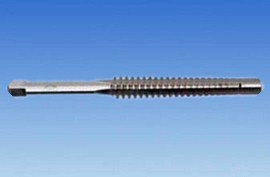Why Trapezoidal thread taps are an improvement over square thread forms
Posted by XuFrank on June 26th, 2017
 Thread forms with trapezoidal outlines are classified as trapezoidal thread form structure. Typically they find application in larger loads; it finds application in lathe screws and a vise. Taps and dies ensure that instruments and machines which use them work fine. Each of the thread taps come with a specific angle. Trapezoidal thread taps come with an angle of 30 degrees. In practice however, manufacturers use ACME Thread forms which has an angle of 29 degrees.
Thread forms with trapezoidal outlines are classified as trapezoidal thread form structure. Typically they find application in larger loads; it finds application in lathe screws and a vise. Taps and dies ensure that instruments and machines which use them work fine. Each of the thread taps come with a specific angle. Trapezoidal thread taps come with an angle of 30 degrees. In practice however, manufacturers use ACME Thread forms which has an angle of 29 degrees.
Originating in the 19th century, ACME thread taps came as an improvement over square type threads. Since the latter was difficult to produce and handle, ACME became the order of the day. The choice shifted moreover due to the strength of the taps shifting to the base in square forms. Manufacturers found out that an improvement could be carried out by reducing the angle to 29 degrees; it widened the base and made it stronger.
Characteristics of trapezoidal thread taps:
The trapezoidal thread tap follows ISO standards and is perhaps more efficient than square type taps. Some of the mutable characteristics that demand special mention are:
This type of thread taps has a base angle of 30 degrees. According to ISO certification standards, it is written as Tr60*9. Here ‘Tr’ stands for Trapezoidal, 60 is diameter and 9 is the pitch in millimeters.
Apart from the usual type, this thread form also comes under 10, 12, 14, 16, 24 etc. nominal diameters. Corresponding to each of these, there are various pitch ranges which extend up to 12mm.
Trapezoidal thread taps enhance linear motion during rotation which is usually initiated by heavy loads. Consider using thread forms for lead screws for forklifts and valve steerings.
Thread forms work under definite load factors called chip loads. Each of the teeth in the thread forms should be absolutely identical and able to carry similar loads. Users of this thread forms should note the Class of fit and depth of tapping to ensure that it fits well into the die.
Improvement towards ACME thread taps:
Although these are not suitable for radial loads, the wider tooth shape ensures a wider base. It’s usually mechanical engineer’s first choice when it comes to versatility. It cuts faster and ensures that the screw holes last really long.
ACME thread taps provide greater friction than the traditional square forms and hence find application in numerous areas. If you are willing to own a pair of trapezoidal or ACME thread forms, make sure
The area between the root and crest is evenly distributed throughout. However, in some areas a minimum allowance is acceptable.
The Pitch diameter is of primary importance and this is what adds that unique characteristics. The difference in the external centralized ACME thread taps entail minor allowances which should, however, be less than internal centralizing thread.
Applications of Trapezoidal thread taps:
From minute camera lens movements to steering wheels, short length thread forms find usage in various areas. The long length thread forms find usage in testing machines, and conveyors and various machine tools. Trapezoidal thread taps finds usage in areas especially when higher friction is a necessity.